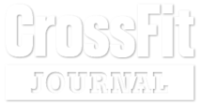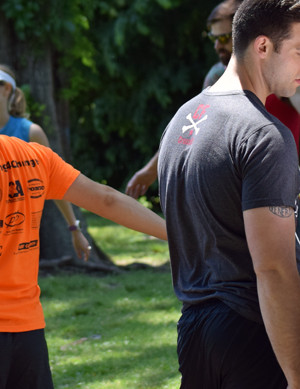Snatches
Snatches
By: Reuben Pearlman
CrossFit is chalk-full (pun intended) of unique terms for exercises: WOD, AMRAP, and EMOM, just to name a few. Many athletes entering a CrossFit box for the first time are also introduced to the names for common barbell lifts like the squat, deadlift, and press. Even new CrossFitters with backgrounds in fitness, including high school sports and commercial gym memberships, are often unfamiliar with the Olympic lifts that CrossFit is arguably built on; they may know what a squat is but may not be able to perform one. Those foundational lifts, namely the snatch and the clean and jerk, are barbell lifts that require speed, power, and total body control. Many people can spend their entire lives working out in their local health club without ever seeing or hearing of these lifts. You may have noticed that we’ve recently been doing quite a bit of these snatch lifts. And that got me curious to learn some more about this uncommon, yet oh so powerful lift, the snatch.
To put it simply, the snatch is performed by the athlete lifting the bar as high as possible and pulling themselves underneath it in a squat position, receiving the bar overhead with the arms straight.
Arthur Drechsler, in The Weightlifting Encyclopedia: A Guide to World Class Performance, identifies six distinct phases of the pull in the snatch:
First Phase: The lifter begins the first phase of the pull, or “Pre-lift off”, with the feet placed approximately hip width apart, toes turned out slightly with the bar above the mid-foot. The shins will be inclined toward the bar so that the shin is touching or close to the bar. Hips are placed so that the top of the thigh is approximately parallel to the ground but may also be slightly higher or lower depending on the lifter. The lifter’s back should be straight, no excessive curvature or rounding in the lumbar spine, with slight extension of the thoracic spine and shoulders slightly pulled back. The shoulders should be positioned so that they are directly over or slightly forward of the bar. The bar is gripped with a very wide grip. The neck should be positioned in line with the torso or slightly more vertical. During the first pull, the lifter begins to exert force on the bar, separating the weight from the platform.
Second Phase: The second phase of the pull, or “preliminary acceleration,” begins with the weight separated from the floor. In the second phase, the lifter begins by extending the knee and moving the hip upward while maintaining a constant back angle relative to the floor. During this phase, the lifter pulls the bar closer to their body and the center of gravity of the lifter shifts toward the heel. During this phase, the lifter begins to accelerate the bar and towards the end of the phase, the torso begins to assume a more vertical position.
Third Phase: During the third phase, or “adjustment phase,” the lifter begins to position their body appropriately for the final explosive pull. The knees typically perform a “double knee bend,” where the knee bends from the previous extension of the knee during the second phase, and the torso continues to become more vertical. During this phase, the lifter doesn’t apply as great a force on the bar as in the previous phases.
Fourth Phase: During the fourth phase of the pull, or “final acceleration,” the lifter performs the final acceleration on the bar. This is executed by explosively extending the hip, knee, and ankles (or plantar-flexing), followed by an upward elevation of the shoulders (the “shrug”). The lifter brings their feet off of the ground and moves them into the squat position as a result of this phase. The lifter’s torso will usually lean slightly backwards during this phase, and the bar is accelerated upward with a slightly arched trajectory.
Fifth Phase: The fifth phase of the pull, or “unsupported squat phase,” occurs when the lifter has fully extended their knees, hips, and ankles, and begins to move downward into the squat position
Sixth Phase: The sixth phase, or supported squat under, occurs when the lifter’s feet have landed flatfooted on the platform and the lifter pulls themselves into a squat position. The lifter then receives the bar overhead with the arms completely straight. From this position, the lifter recovers by squatting the weight to a fully erect position while maintaining the bar position overhead.
So now that you know a little bit more about how the snatch is performed, why are we doing it so much? Or, put another way, what is doing this lift doing for me as a CrossFit athlete?
- First, and arguably most important, is the hotly debated evidence that Olympic weightlifting has numerous safety and injury prevention benefits. Various studies have shown Olympic weightlifting to be the safest form of resistance training there is.[1] Importantly, for those of you that have heard reports about the dangers of this type of training, you should know that few have been found creditable.
- Another benefit of the snatch is the amount of muscles used in the lift. The snatch involves basically every muscle in the human body, and this entails a great workout. Although it won’t really target your pecs or biceps, the snatch will build loads of sexy muscle all over your body, from your calves to your traps.
- Another important benefit of the snatch is that it teaches the body to fire all the muscle fibers at once, to explode. Numerous studies show that the snatch will make the athlete strong, fast, flexible, and functional. [2]The athletic benefits from snatching really can’t be understated.
- Snatching will also have an effect on bone mineral density (read: Olympic weightlifting can help prevent osteoporosis). Studies show that Olympic weightlifting has the ability to develop strong healthy bones that are resistant to fractures.[3]
- Planks and hollow rocks are great, if you’re into that sort of thing. But you might be surprised to learn that the snatch is a great way to built core stability. “A strong core is necessary to maintain the torso position from the ground up through the first and second pull,” writes Wil Fleming in Complete Olympic Lifting. Also, stabilizing heavy weight above your head requires a tremendous amount of core stabilization.
- Supporting a heavy weight overhead, such as receiving the bar in the snatch, develops “intrinsic shoulder strength” and a great deal of shoulder stability, says Fleming. With the shoulders packed into the body, the dynamic stability function of the rotator cuff and all the supporting musculature around the shoulder and scapulothoracic joint have to create a stable platform so the bar can be balanced in the correct position overhead.
- It’s FUN to do! People enjoy the feeling of the barbell being weightless as they drop underneath it. Or, they enjoy the speed that it takes to complete the lift, or maybe they just enjoy mastering a technical skill. One thing is for certain – performing the snatch is never boring.
[1] Granhed, H. et al. Low back pain among retired wrestlers and heavyweight lifters. The American Journal of Sports Medicine,16(5):530-533. 1988; Hamill, B. Relative Safety of Weightlifting and Weight Training. Journal of Strength and Conditioning Research, 8(1):53-57. 1994; Stone, M. H., A. C. Fry, M. Ritchie, L. Stoessel-Ross, and J. L. Marsit. Injury potential and safety aspects of weightlifting movements. Strength and Conditioning. June: 15-21. 1994.
[2] Hoffman, Jr, J Cooper, M Wendell, and J Kang. “Comparison of Olympic Vs. Traditional Power Lifting Training Programs in Football Players.” 18 (2004): 129-135. Journal of Strength and Conditioning Research 18 (2004); Tricoli, V, L Lamas, R Carnevale, and C Ugrinowitsch. “Short-Term Effects on Lower-Body Functional Power Development: Weightlifting Vs. Vertical Jump Training Programs.” 19 (2005): 433-437. Journal of Strength and Conditioning Research 19 (2005).
[3] Conroy, Bp, Wj Kraemer, Cm Maresh, Sj Fleck, Mh Stone, Ac Fry, Pd Miller, and Gp Dalsky. “Bone Mineral Density in Elite Junior Olympic Weightlifters.” (1993): 1103-1109. Medicine and Science in Sports and Exercise 25 (1993).





Leave a Reply
Want to join the discussion?Feel free to contribute!